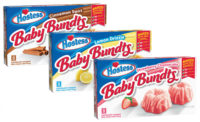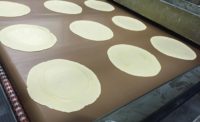Doughnuts now run the gamut from sweet to savory, and there are no flavor combinations that are off limits: you might see a Fruity Pebbles doughnut, and maple bacon has become commonplace. And growth continues.
Muffins and pastries are experimenting with new flavors too, and some are even touting vegan or clean-label claims.
Overview | Bread | Tortillas | Sweet Goods | Snack Cakes | Pizza | Desserts | Cookies | Buns & Rolls | Bars | Breakfast Products
It’s a good time to be in sweet goods, as product diversity provides a wide array of choices to help drive growth, with traditional indulgence on one end of the spectrum and bona-fide health on the other, and plenty of steps in between.
Market data
Looking at data from IRI, Chicago, from the past 52 weeks ending March 25, 2018, the overall pastry/doughnuts category saw a bit of growth, up 1.76 percent to $5.1 billion. Private label leads every sweet goods segment. Doughnuts is the largest segment in the category, growing 1.38 percent to $2.0 billion. Of the top five companies in the segment, McKee Foods saw the most growth, up 6.6 percent to $288.0 million. IRI documented strong growth at United States Bakery, up 10.61 percent to $24.1 million, and at Clyde’s Delicious Doughnuts, up 37.67 percent to $19.1 million.
The pastry/Danish/coffee cakes segment trended down slightly, dropping 1.49 percent to $1.9 billion. Private label saw the best growth for the year, per IRI, up 10.60 percent to $443.8 million. Hostess Brands also had a good year in the segment, up 9.09 percent in dollar sales to $112.3 million. The muffins segment saw the most growth for the year, up 9.12 percent to $1.1 billion. Here, private label is seeing its tightest competition. Private label was up 12.83 percent to $359.5 million, while Bimbo Bakeries USA grew its muffin business by 15.78 percent to $346.3 million. Other companies in this category that experienced large jumps in sales included McKee Foods, up 19.32 percent to $43.0 million, and Café Valley Bakery, up 14.83 percent from last year to $30.5 million in sales.
Looking back
“In the sweet goods category, we are seeing indulgence and premiumization trending, along with convenience and better-for-you options,” says Anker Fog, business development and marketing analyst, bakery, AAK, Edison, NJ. One way sweet goods manufacturers made better-foryou choices easier to find was through offering 100-calorie portion-controlled packaging or “thin” packs, which would fall under convenience and better-for-you umbrellas, he says.
“On the indulgent side, taste still drives consumer purchasing,” continues Fog. “Simply put, if it doesn’t taste good, customers aren’t going to buy it. Because of this, we’re seeing a lot of innovation around unique and interesting flavors that help manufacturers in differentiating their products.”
On the foodservice side, Dunkin’ Donuts is a good example of this. The coffeehouse chain frequently releases limited-time doughnuts, some of which have intriguing flavors, including Frosted Sugar Cookie and Gingerbread Cookie doughnuts, released in November 2017, and its seasonal doughnuts, including Mint Brownie and Spring Fling doughnuts, released in February 2018.
Krispy Kreme is constantly innovating, as well. In April 2018, it released NUTTER BUTTER Cookie Twist and CHIPS AHOY! doughnuts. For sweet goods, consumers may be less concerned with specific health claims or clean label values than in other categories, yet to achieve a premium brand position, it remains critical to highlight quality ingredients and reduce additives, says Jeff Billig, vice president and general manager, Delavau Food Partners, Philadelphia. “Delivering a cleaner label and functional claims will continue to be paramount for brands that want to grow.”
Dawn Foods, Jackson, MI, recently created a line of clean-label doughnut mixes called Dawn Baker’s Truth. The product contains no artificial preservatives, sweeteners, flavors, colors or high-fructose corn syrup, and is PHO-free, says Jennifer LaPaugh, senior director, global market research and insights.
The mix was created in response to what Dawn Foods calls demand for simple and pure eating. “People are craving a no-fuss approach to eating with pragmatic principles: eat real food, made with familiar, wholesome ingredients,” says LaPaugh.
AAK now offers a wide variety of cleaner-label solutions, as well, including Cisao, a line of multifunctional palm-based, PHO-free bakery fats; Neutresca, a line of hard fat flakes and stabilizers; and Essence, its line of high-performance, low-saturated-fat bakery shortenings. Select ingredients can also encourage product trial. According to Mintel’s 2018 Flavor Trends, 51 percent of consumers are willing to try an unfamiliar ingredient if it provides a functional benefit, notes Mollie Woods, executive director, Cherry Industry Administrative Board, Dewitt, MI. “Specialty dried fruits like U.S.-grown Montmorency tart cherries are a unique ingredient that can bring functional benefits to a range of products.”
Sweet goods are well suited to Insta fame: Consumers have been Instagramming pictures of unique and interesting concoctions. Adventures in hybrid sweet goods mashups started with the cronut (croissant doughnut) and now includes items like the cruffin (croissant muffin), donnoli (doughnut cannoli), wonut (waffle doughnut) and bagnut (bagel doughnut).
Sheer size can also attract attention. Wolferman’s Limited-Edition Gigantic Cinnamon Roll, weighing in at 5 pounds, was released in April 2018, and retails for $49.99 on Wolferman’s website (the bakery is the current Guinness World Records title holder for the biggest cinnamon roll).
“Consumer desires in sweet goods run toward two quite different areas: on the one hand, clean-label products with lower levels of sugar, and on the other, outrageously colorful and visually stunning foods made for social sharing,” explains Jamie Wilson, director, marketing and culinary, Parker Products, Fort Worth, TX. “We expect to see both types of application flourish in coming years.”
Looking forward
“One recognized category that we see growing is trendworthy food, a product specifically created to see success online,” says Wilson. “These are typically visually stunning products that are highly indulgent, like the cruffin (croissant muffin) and milky bun ice cream sandwiches— essentially doughnuts filled with colorful ice cream. We expect to see more of these eye-catching hybrid products in the future.” Unique sweet goods beg to be shared. “Consumers have developed a growing desire to show off products that are unique, memorable and shareable,” says LaPaugh. “An ingredient that we’ve seen traction behind that does this well is ube, a purple sweet yam from the Philippines that is being used to both sweeten baked goods and also create really vibrant colors.”
LaPaugh says that she is also seeing other ethnic flavors in sweet goods like dulce de leche, cajeta (sweetened, caramelized goat’s milk) and matcha green tea. She’s also seeing an influence from the floral industry, with flavors like rosewater and elderflower.
Even though the category offers many indulgent choices for consumers, sugar reduction will still be a focus, says Bill Gilbert, certified master baker, principal food technologist, Cargill, Minneapolis. “We expect sugar reduction will get more attention in the months ahead—even in the indulgent sweet goods category—as U.S. bakers begin to prepare for the redesign of the Nutrition Facts panel, with its inclusion of added sugars.”
Cargill offers blends of ViaTech stevia, Zerose erythritol and Oliggo-Fiber chicory root fiber to help create muffins with 25 percent less sugar, yet still keep cost-of-use in check and deliver on consumer expectations for an indulgent treat, says Gilbert.
“Choosing the right ingredients is an increasingly complex decision, especially in today’s clean-label environment,” says Gilbert. “While consumers may say ‘don’t mess with my treats,’ muffins, pastries and even doughnuts aren’t immune to clean-label desires. Consumers are looking for shorter ingredient lists, with names they recognize. We’re also seeing more bakeries request organic, non- GMO and allergen-free ingredient options.” Muffins are good candidates for nutritional additions—and bakers developing savory pastries might look to vegetables for inspiration. “Vegetables like sweet potatoes, pumpkin, carrot, zucchini and rhubarb are great to bake with because they taste great and are easily incorporated into sweet baked goods,” says LaPaugh.
Sometimes the color of a product can entice consumers, as well. “Making consumers aware of the color in fruits and vegetables when describing a product is another trend that is up and coming,” says Woods. “It entices consumers by appealing to their visual senses, not just taste.”
Another trend that may continue in the next year is “throwback flavors,” specifically with millennials, says Fog. “Innovation has largely been driven around unique flavors, cross-branding with well-known brands and premium indulgence. Additionally, we have seen a lot of new product development around ‘throwback flavors’ that seek to capitalize on millennials’ nostalgia for products they consumed as kids.”
The idea of “enlightened eating”—similar to clean label—will continue to flourish in 2018. “With this trend, consumers are proactively looking to find their own personal balance between health and indulgence, and are seeking inherent benefits from food—like protein, which helps build muscle, or probiotics that contribute to healthy digestion. Consumers are using food to fuel their bodies,” says LaPaugh. “By adding ingredients with nutritional benefits like nuts, seeds, alternative grains—quinoa, barley, millet—and Greek yogurt, bakers can easily create sweet baked goods that will delight their consumers’ desire for fuel and great taste.”
This is a shifting focus for select shopper demographics. “While sweet goods may not seem like the most likely candidate for contributing nutrition, we expect to see increasing focus from consumers on making every food decision count, resulting in fortification finding its way into even more-indulgent products,” says Billig.
Delavau Food Partners predicts vitamins and minerals will appear in more sweet goods. According to a company survey of 1,045 consumers, 80 percent of people make a conscious decision to incorporate vitamins and minerals into their diets, either through food or supplements.
“Consumers are seeking natural foods that offer the same benefits they receive from over-the-counter medicine and overall functional foods that could offer health benefits, in addition to a great snack,” says Woods.
On the flip side, we will continue to see more consumers reach for something indulgent, says Fog. “The sweet spot for new products in sweet goods is something that is indulgent, better-for-you and convenient to eat.”
Overview | Bread | Tortillas | Sweet Goods | Snack Cakes | Pizza | Desserts | Cookies | Buns & Rolls | Bars | Breakfast Products











